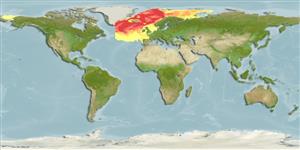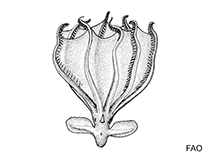Cirroteuthis muelleri Eschricht, 1836
Müller's cirroctopod| Native range | All suitable habitat | Point map | Year 2050 |

|
| This map was computer-generated and has not yet been reviewed. |
| Cirroteuthis muelleri AquaMaps Data sources: GBIF OBIS |
Google image | No image available for this species;
drawing shows typical species in Cirroteuthidae.
Classification / Names Populärnamn | synonymer | CoL | ITIS | WoRMS
Cephalopoda | Octopoda | Cirroteuthidae
Environment: milieu / climate zone / djupintervall / distribution range Ekologi
Bentopelagisk; djupintervall 0 - 4854 m (Ref. 1987). Temperate
Distribution Länder | FAO områden | Ekosystem | Förekomster | Utplanteringar
Circum Arctic and Northern Atlantic: Faroe Islands, Greenland and Iceland. Questionably found in New Zealand. Temperate to polar.
Length at first maturity / Size / Weight / Age
Könsmognad: Lm ? range ? - ? cm Max length : 150 cm TL hane/ej könsbestämd; (Ref. 114214)
Life cycle and mating behavior Könsmognad | Reproduktion | Lek | Eggs | Fecundity | Larvae
Main reference
referenser | Koordinator | Medarbetare
Bisby, F.A., M.A. Ruggiero, K.L. Wilson, M. Cachuela-Palacio, S.W. Kimani, Y.R. Roskov, A. Soulier-Perkins and J. van Hertum 2005 Species 2000 & ITIS Catalogue of Life: 2005 Annual Checklist. CD-ROM; Species 2000: Reading, U.K. (Ref. 19)
IUCN Red List Status
(Ref. 130435: Version 2025-1)
CITES status (Ref. 108899)
CMS (Ref. 116361)
Threat to humans
Human uses
| FishSource |
Verktyg
Ytterligare information
Födosammansättning
Födointag
Predatorer
Max. ages / sizes
Length-weight rel.
Length-length rel.
Length-frequencies
Mass conversion
Abundans
Internet-källor
BHL | BOLD Systems | CISTI | DiscoverLife | FAO(Publication : search) | Fishipedia | GenBank (genome, nucleotide) | GloBI | Gomexsi | Google Books | Google Scholar | Google | PubMed | Tree of Life | Wikipedia (Go, sök) | Zoological Record



